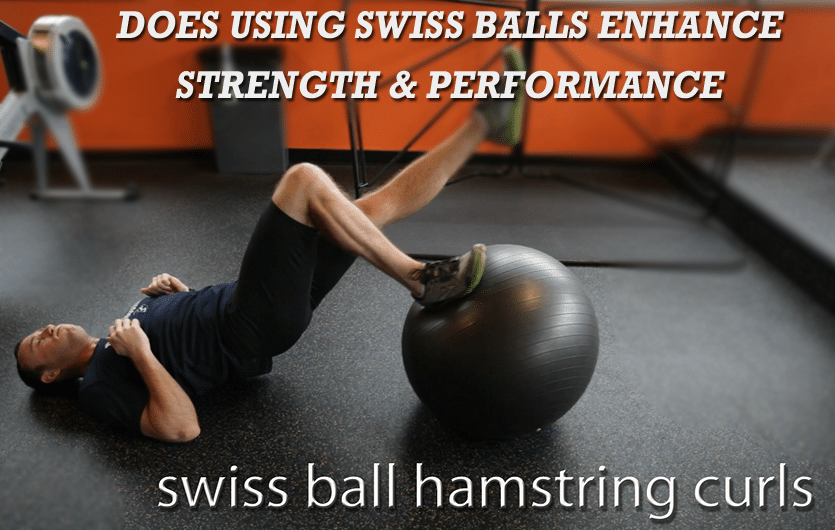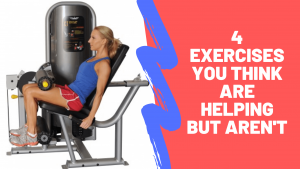
Maintaining your muscular strength with a regular strength routine is important for performance and for staying healthy. But deciding on which exercises to do and how to do them can be a confusing process.
Different variants of “standard” exercises like push-ups, planks, and crunches become popular, and it’s not always easy to tell if any one particular way of doing an exercise is “correct.”
Today, we’ll look at the use of stability balls and other unstable surfaces as aids to doing core and general strengthening exercises.
The type of equipment used for unstable exercises includes full-sized Swiss balls, miniature balls, Bosu balls (“half” of a Swiss ball), and thick foam or rubber mats, but the argument for their use is the same: they are supposed to increase the demands on your stabilizing muscles, ramping up the difficulty of the exercise and resulting in a better training effect.
How we can measure the impact of unstable surfaces
Fortunately, unlike some fads in the running world which make more nebulous and difficult-to-measure claims, the effects of unstable surfaces on strength and performance is relatively easy to measure. Biomechanical laboratories at most universities and hospitals are equipped with electromyography machines, which use skin-mounted electrodes to measure the electrical signals sent to your muscles through your nerves.
By measuring the intensity of these signals, researchers can get a pretty clear idea of how strongly a particular exercise engages the muscles in question. This, combined with some basic testing of strength and performance after a program of exercises on unstable surfaces, can determine whether or not it is worth investing in a Swiss ball, Bosu ball, or other unstable surface.
Swiss balls on core stability and balance exercises
The first study we’ll look at that used this sort of design was published by Ludmila Cosito-Lima and others in 2003. Cosito-Lima et al. studied a group of 15 women performing Swiss ball core stability and balance exercises for five weeks, studying the electromyographical signals in their abdominal and back muscles during the exercises, and measuring the gains in absolute strength at the end of the study.
The experimental group was compared to a control group who performed the same type of crunch and back extension exercises on the floor with no unstable surface.
Though the experimental group demonstrated significantly more activation of their abdominal and back muscles during the exercises, they did not become any stronger than the control group. A counter-argument might be that the experimental group could have developed better balance—unfortunately, Cosito-Lima et al. did not measure this.
Do unstable surfaces improve strength and performance in the upper body?
In contrast, two other studies found that using Swiss balls as a base for upper body strength exercises had a marginal or insignificant effect on muscle activation.
First, Gregory Lehman and colleagues directed a 2005 study which found only variable, non-significant changes in muscle activation when doing various upper-body free-weight exercises while seated on a Swiss ball when compared to using a flat bench, and a 2007 follow-up study by the same group found no change when doing pushups on a Swiss ball when compared to a bench.
Second, the case for unstable-surface strength training is further called into question by a 2007 study which directly evaluated the effects of unstable surface training on NCAA DI soccer players.
The study split the men’s soccer team at a DI university into two groups, both of which completed a 10-week strength program consisting of lower body strength and balance exercises. The experimental group did their exercises on inflatable rubber disks, while the control group did them on flat ground.
After the 10-week period, the soccer players were tested in vertical jump height, 40-yard and 10-yard sprint times, and shuttle-run agility times, which had also been measured at the outset of the study.
While both the experimental and control groups improved their marks, the athletes who did their exercises on the inflatable disk did not improve as much as those who exercised on the ground. While the authors pointed out that the use of unstable surfaces may be useful when rehabilitating injury, they did not recommend it for healthy athletes.
What about running-specific strength?
The reasons for the attenuated improvements in the athletes who used the unstable surface could be chalked up to the principle of specificity—though the unstable surface may indeed have increased the difficulty of the exercises, it was not in a way that was relevant to the purpose of the exercise (in this case, to become a faster, more agile, and more explosive athlete).
A review study by Jeffrey Willardson points out that unstable exercises “may not be effective in developing the type of balance, proprioception, and core stability required for successful sports performance.”
Another review study by Paul Marshall and Bernadette Murphy at the University of Auckland in New Zealand questions whether training the body to activate the core muscles more intensely during exercise is even desirable, as it may be that optimal stability occurs when core muscle activity not excessively high.
So, while unstable surfaces like Bosu balls and Swiss balls may increase core muscle activation for abdominal exercises like sit-ups and crunches, they do not seem to have an effect on muscle activation in upper or lower-body strength exercises like push-ups, bench presses, or squats.
Additionally, the type of training stimulus provided by unstable surfaces is probably not ideal for developing the type of strength, balance, and coordination required for performance while running. But this does not mean that unstable exercises and related equipment are of no use to a runner.
Conclusion
- As we’ve seen in previous articles, developing ankle proprioception and strength through balance training on a Bosu ball or other unstable surface can be very helpful when recovering from or trying to prevent an ankle sprain, and studies have not yet investigated the effects of unstable surfaces on hip muscle strength, which is in principle similar to training ankle balance.
- Additionally, some exercises (like hamstring curls and adductor squeezes) are easily done with a Swiss ball if you don’t have access to a fully equipped weight room.
- If you decide to use unstable surfaces for some of your strength training, it should only be for exercises that specifically target balance.
- Doing “performance” exercises like squats, lunges, or pushups on an unstable surface is not likely to result in better results than doing those same exercises on flat ground.
If you’re having a difficult time deciding what exercises you should include in your strength training routine, our strength training guide for runners can answer all the questions for you. Not only do we provide you with the most effective, running-specific exercises, but we tell you how and when to include them into your weekly training routine based on your experience level and goal race distance. Grab your copy here.




